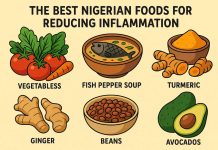
Most people know about major food deficiencies but only few know about vitamin deficiencies. Hence, this article will enlighten you, if you are in this category .Stay tuned!
Vitamins are essential organic compounds that your body needs to function properly. They are required in small amounts, but their absence or deficiency can cause significant health problems.
There are two main categories of vitamins: water-soluble and fat-soluble. Water-soluble vitamins include vitamin C and the B-complex vitamins (thiamine, riboflavin, niacin, pantothenic acid, biotin, vitamin B6, and vitamin B12). These vitamins are easily absorbed by the body and are not stored in large amounts, so they need to be replenished regularly through diet or supplementation.
On the other hand, are the fat-soluble vitamins. They include vitamins A, D, E, and K. These vitamins are absorbed and stored in the body’s fat cells. Hence, excess amounts can accumulate and cause toxicity. Therefore, it is important to consume them in moderation and not to exceed the recommended daily intake.
What are Vitamin deficiencies?

Vitamin deficiencies occur when the body does not get enough of a specific vitamin it needs to function properly. There are 13 essential vitamins that your body needs to maintain health and wellness, and each has its own set of functions.
Most common Deficiencies :

1.Vitamin D: This vitamin is essential for bone health, and deficiencies are common. Especially, in people who live in northern latitudes with less exposure to sunlight. It’s deficiency, manifests as rickets in children characterized by weak and soft bones. Whereas in adults, what we find is osteomalacia .These adults ,are more prone to fractures.
2.Vitamin B12: This is important for maintaining healthy nerves and blood cells. So, its deficiency can lead to fatigue, weakness, and neurological problems.
3.Vitamin C: This vitamin is important for immune function and wound healing. Its deficiency causes scurvy, a disease characterized by bleeding gums. It also causes skin rashes.
4.Vitamin A: This one is important for vision, immune function, and skin health. If it is deficient, in the body, you can develop night blindness, dry eyes, and skin problems.
5.Vitamin E: This vitamin supports skin health and immune function.When it is deficient, you may experience muscle weakness and vision problems.
6.Vitamin K: This vitamin is important for blood clotting and bone health, and deficiencies can lead to excessive bleeding and weakened bones.
Prevalence values in Nigeria:
Vitamin deficiencies are a global health issue, but the figures in Nigeria as a case study are not too good. Take a look!
Vitamin A deficiency: The World Health Organization (WHO) says the prevalence of vitamin A deficiency among pre-school children in Nigeria is 29.5%.
Deficiency in Vitamin D : Studies show that the prevalence of vitamin D deficiency ranges from 29.6% to 67.7%.
Vitamin B12 deficiency: The prevalence of vitamin B12 deficiency among Nigerians varies widely, ranging from 7.5% to 77.7% in different studies.
Folate deficiency: Folate deficiency has estimates ranging from 13.8% to 55.6%.These are pretty large values.
There are stages of vitamin deficiencies:

Vitamin deficiencies may occur in different stages in different people. The stages were framed, based on the severity and duration of the deficiency.
Here they are :
Depletion Stage: This stage occurs when the body’s vitamin stores become depleted due to inadequate intake or absorption of the vitamin. At this stage, there may not be any noticeable symptoms.
Early Deficiency Stage: This stage occurs when the body’s vitamin stores are significantly depleted. Hence, there may be some signs such as fatigue, weakness, and anemia.
Marginal Deficiency Stage: Here, the deficiency becomes more severe, and there may be more obvious symptoms. These include muscle weakness, cognitive impairment, and decreased immune function.
Manifest Deficiency Stage: This is the most severe stage of vitamin deficiency, where there are obvious and significant health problems related to the deficiency. For example, vitamin C deficiency can manifest as scurvy, while vitamin A deficiency can cause blindness.
The progression of vitamin deficiency can vary depending on the individual’s age, health status, and other factors.
How to test for vitamin deficiencies:

Yes, obvious signs can tell us that a deficiency is ongoing. But other times, we only have hints and we do only so much as suspect these deficiencies. However, just like any other condition, early detection is very important as regards treatment regimen and having a good prognosis.
So how do we measure vitamin levels, do we know when they’re below optimal?
1.Blood tests: Blood tests are the most common way to measure vitamin levels. The blood is drawn and sent to a laboratory for analysis. This method is used for measuring vitamin B12, vitamin D, and folate levels.
2.Urine tests: Some vitamins, such as vitamin C and thiamine, are excreted in the urine. Urine tests can be used to measure these vitamin levels.
3.Tissue biopsy: In some cases, a small tissue sample may be taken and analyzed for vitamin levels. This method can used for measuring vitamin A levels when absolutely necessary as it is invasive.
4.Hair analysis: Hair analysis can be used to measure certain mineral levels, which can indirectly reflect vitamin levels. However, this method is not commonly used for measuring vitamin levels.
However, it is important to note that measuring vitamin levels is both circumstance and vitamin specific.
The Nigerian government’s initiative
Vitamin deficiencies are very common, especially in rural areas. So our government has put forward several initiatives to tackle this.
One of the most notable is the National Food and Nutrition Policy, which was launched in 2001 to address malnutrition in the country.
The policy includes several strategies to improve the availability and accessibility of nutritious foods, particularly in rural areas. These include promoting the production and consumption of vitamin-rich foods such as fruits, vegetables, and legumes, as well as fortifying staple foods such as wheat flour, sugar, and salt with essential vitamins and minerals.
Furthermore, the government has established community-based nutrition programs, which provide education and support to rural communities on how to improve their diets and prevent malnutrition.
Lastly, the government launched several initiatives to provide free or subsidized vitamin supplements to vulnerable groups such as pregnant women and young children.
And so far, these initiatives have been successful in reducing the incidence of vitamin deficiencies in these populations.
Take a short quiz on vitamin deficiencies to see what you’ve learnt!
Till next time, stay healthy!










I really loved reading your blog. It was very well authored and easy to undertand. Unlike additional blogs I have read which are really not tht good. I also found your posts very interesting. In fact after reading. I had to go show it to my friend and he ejoyed it as well!
For a long time me & my friend were searching for informative blogs, but now I am on the right place guys, you have made a room in my heart!
Thanks for Nice and Informative Post. This article is really contains lot more information about This Topic.
Hey there, I think your blog might be having
browser compatibility issues. When I look at your blog site in Firefox, it
looks fine but when opening in Internet Explorer,
it has some overlapping. I just wanted to give you a quick
heads up! Other then that, superb blog!
Today, I went to the beachfront with my children. I found a sea shell and gave it to my 4 year old daughter and said “You can hear the ocean if you put this to your ear.” She placed the shell to her ear and screamed.
There was a hermit crab inside and it pinched her ear. She never wants to go back!
LoL I know this is entirely off topic but I had to tell someone!
Magnificent goods from you, man. I have understand your stuff previous to and
you’re just extremely magnificent. I really like what you’ve
acquired here, certainly like what you’re stating and the way in which you say
it. You make it enjoyable and you still care for to keep it sensible.
I cant wait to read much more from you. This is actually a wonderful website.
Hi! Someone in my Facebook group shared this website with us so
I came to check it out. I’m definitely enjoying the information.
I’m bookmarking and will be tweeting this to my followers!
Terrific blog and superb design and style.
Hi there, just wanted to say, I loved this blog post. It was practical.
Keep on posting!
Ridiculous story there. What occurred after? Good luck!
You’re so awesome! I don’t believe I have read anything like this before.
So great to discover someone with a few original thoughts on this subject.
Really.. many thanks for starting this up. This web site
is one thing that’s needed on the web, someone with some originality!
This article provides clear idea for the new viewers of blogging, that actually how
to do running a blog.
I really like your blog.. very nice colors & theme. Did you make this website
yourself or did you hire someone to do it for you? Plz respond
as I’m looking to create my own blog and would like to know where
u got this from. many thanks
I have read so many articles or reviews regarding the blogger lovers however
this article is really a good post, keep it up.
That is a very good tip especially to those fresh to the blogosphere.
Simple but very precise information… Many thanks for sharing this one.
A must read post!
Hi are using WordPress for your blog platform? I’m new to the blog world
but I’m trying to get started and create my own. Do you need any
coding knowledge to make your own blog? Any
help would be greatly appreciated!
Hi all, here every one is sharing such know-how,
so it’s pleasant to read this webpage, and I used to go to see this website
daily.
This article is really a nice one it assists new net
people, who are wishing in favor of blogging.
This is my first time pay a visit at here and i am genuinely impressed
to read everthing at alone place.
Excellent article! We are linking to this great post on our website.
Keep up the good writing.
Thanks for your marvelous posting! I really enjoyed reading it, you can be a great author.I will
be sure to bookmark your blog and will often come back at some point.
I want to encourage one to continue your great work, have a nice day!
Great site you have here but I was wondering if you knew of any
discussion boards that cover the same topics
discussed here? I’d really love to be a part of online community where
I can get advice from other experienced individuals that share the same interest.
If you have any recommendations, please let me know.
Kudos!
Good info. Lucky me I recently found your website by chance (stumbleupon).
I’ve saved it for later!
Hi there to every body, it’s my first go to
see of this weblog; this webpage includes amazing
and truly good stuff for readers.
Hey there just wanted to give you a quick heads up.
The text in your content seem to be running off the screen in Firefox.
I’m not sure if this is a format issue or something to do with
web browser compatibility but I figured I’d post to let you
know. The style and design look great though!
Hope you get the issue solved soon. Kudos
I’ve been browsing online greater than 3 hours nowadays, but
I never discovered any interesting article like yours.
It’s lovely price enough for me. In my view, if all web owners
and bloggers made good content material as you probably
did, the web will probably be a lot more helpful than ever before.
Greetings from Los angeles! I’m bored at work so I
decided to check out your website on my iphone during lunch break.
I enjoy the information you provide here and can’t wait to take a look when I get
home. I’m surprised at how quick your blog loaded on my phone ..
I’m not even using WIFI, just 3G .. Anyhow, good blog!
Hello, I enjoy reading all of your article. I like to
write a little comment to support you.
Excellent items from you, man. I have keep in mind your stuff prior to and
you’re just extremely magnificent. I actually like what you’ve received here, really like what you are saying and the best way wherein you say it.
You’re making it enjoyable and you continue to care for to keep it sensible.
I cant wait to learn much more from you. This is actually a terrific
web site.
This is really fascinating, You’re an excessively skilled
blogger. I have joined your rss feed and look ahead to searching for extra of your fantastic post.
Also, I’ve shared your site in my social networks
Fantastic site. A lot of helpful information here. I’m sending it to several
friends ans additionally sharing in delicious. And certainly,
thanks on your sweat!
For most up-to-date news you have to pay a visit web and
on the web I found this site as a best web page for most recent updates.
I’m constantly searching on the internet for posts that will help me. Too much is clearly to learn about this. I believe you created good quality items in Functions also. Keep working, congrats!
Thanks for Nice and Informative Post. This article is really contains lot more information about This Topic.
Such a very useful article. Very interesting to read this article.I would like to thank you for the efforts you had made for writing this awesome article.
Wow, this is really interesting reading. I am glad I found this and got to read it. Great job on this content. I like it.
You have made some decent points there. I looked on the internet for more information about the issue and found most people will go along with your views on this web site.
You have made some decent points there. I looked on the internet for more information about the issue and found most people will go along with your views on this web site.
Appreciate the recommendation. Will try it out.
I was very impressed by this post, this site has always been pleasant news Thank you very much for such an interesting post, and I meet them more often then I visited this site.
Excellent .. Amazing .. I’ll bookmark your blog and take the feeds also…I’m happy to find so many useful info here in the post, we need work out more techniques in this regard, thanks for sharing.
At JUNKWISELY Junk Removal, we are committed to responsible and eco-friendly junk removal practices. We understand the importance of minimizing our environmental footprint while efficiently clearing your space of unwanted items. Our dedicated team employs eco-conscious methods, including recycling, donation, and proper disposal techniques, to ensure that as much of your junk as possible is diverted from landfills. By choosing JUNKWISELY Junk Removal, you can trust that your clutter is being handled with care and consideration for the planet, leaving you with a cleaner conscience and a cleaner environment.
I really like your blog. Great article. It’s most evident, people should learn before they are able to
At JUNKWISELY Junk Removal, we are committed to responsible and eco-friendly junk removal practices. We understand the importance of minimizing our environmental footprint while efficiently clearing your space of unwanted items. Our dedicated team employs eco-conscious methods, including recycling, donation, and proper disposal techniques, to ensure that as much of your junk as possible is diverted from landfills. By choosing JUNKWISELY Junk Removal, you can trust that your clutter is being handled with care and consideration for the planet, leaving you with a cleaner conscience and a cleaner environment.
One present why galore businesses opt for postcards is because they are overmuch cheaper to be prefab and this can forbear a lot of expenses on the lengthened run.
Excellent article. I am facing many of these issues as well..
Simply want to say your article is as amazing.
The clearness in your post is just nice and i can assume you’re an expert
on this subject. Fine with your permission let me to grab your RSS feed
to keep updated with forthcoming post. Thanks a million and please carry on the enjoyable work.
I was curious if you ever considered changing the layout of your site?
Its very well written; I love what youve got to say.
But maybe you could a little more in the way of content so people
could connect with it better. Youve got an awful lot of text for only having 1 or 2 pictures.
Maybe you could space it out better?
Hello! Someone in my Myspace group shared this website with us so I came to check it out.
I’m definitely loving the information. I’m book-marking and will be tweeting this to my followers!
Excellent blog and outstanding design and style.
Vitamin D supplements completely changed my mood during winter.
This topic has become increasingly relevant among travelers looking for meaningful and unconventional experiences. From personal adventures and numerous travel blogs, it’s clear that more people are shifting toward discovering hidden gems, immersing in local cultures, and minimizing environmental impact. Exploring new places isn’t just about sightseeing anymore—it’s about forming connections, gaining new perspectives, and sometimes, rediscovering oneself. Whether it’s walking through a quiet village, joining a traditional cooking class, or simply watching wildlife in its natural habitat, these moments are what truly enrich the travel experience. With the growing awareness around sustainability and authentic experiences, it’s time we look beyond the mainstream and embrace journeys that are both enriching and responsible. For anyone planning their next trip, considering these aspects can make a world of difference.
ما يميز صيانة كهرباء الكويت هو الاحترافية العالية والتجاوب السريع مع العملاء. لديهم خبرة كبيرة في مجال الكهرباء وأعمال التمديدات. في ظل كثرة الأعطال الكهربائية، كانت خدمة صيانة كهرباء الكويت منقذة حقيقية لي. يقدمون الدعم الفني وخدمات ما بعد البيع أيضاً بجودة عالية. إذا كنت تبحث عن صيانة كهرباء الكويت فأنت في المكان الصحيح. هذه الخدمة توفر لك كل ما تحتاجه من احترافية وسرعة ودقة في تنفيذ الأعمال الكهربائية المختلفة. لقد جربت العديد من خدمات الكهرباء، ولكن لم أجد أفضل من صيانة كهرباء الكويت. الخدمة ممتازة والدعم متوفر على مدار الساعة مما يجعل التجربة مريحة وآمنة. إذا كنت تبحث عن صيانة كهرباء الكويت فأنت في المكان الصحيح. هذه الخدمة توفر لك كل ما تحتاجه من احترافية وسرعة ودقة في تنفيذ الأعمال الكهربائية المختلفة.
إذا كنت تبحث عن كهربائي منازل الكويت فأنت في المكان الصحيح. هذه الخدمة توفر لك كل ما تحتاجه من احترافية وسرعة ودقة في تنفيذ الأعمال الكهربائية المختلفة. خدمة كهربائي منازل الكويت تعتبر من أهم الخدمات التي يحتاجها كل منزل أو شركة في الكويت. الجودة والسرعة هما ما يميز هذه الخدمة، ويمكن الاعتماد عليها في جميع الأوقات. ما يميز كهربائي منازل الكويت هو الاحترافية العالية والتجاوب السريع مع العملاء. لديهم خبرة كبيرة في مجال الكهرباء وأعمال التمديدات. في ظل كثرة الأعطال الكهربائية، كانت خدمة كهربائي منازل الكويت منقذة حقيقية لي. يقدمون الدعم الفني وخدمات ما بعد البيع أيضاً بجودة عالية. بفضل خدمة كهربائي منازل الكويت تمكنت من إنهاء مشاكل الكهرباء في منزلي بسرعة وكفاءة عالية. شكراً لهذا الفريق الرائع على الخدمة المتميزة.